Kingdom Plantae
Class-11-Science-Biology-Chapter-3-Maharashtra Board
Solution
Question 1.
Choose correct option
A. Which is the dominant phase in Pteridophytes?
a. Capsule
b. Gametophyte
c. Sporophyte
d. Embryo
(c) Sporophyte
B. The tallest living gymnosperm among the following is ..........
a. Sequoia sempervirens
b. Taxodium mucronatum
c. Zamia pygmaea
d. Ginkgo biloba
(a) Sequoia sempervirens
C. In Bryophytes ..........
a. Sporophyte and gametophyte generations are independent
b. Sporophyte is partially dependent upon gametophyte
c. Gametophyte is dependent upon Sporophyte
d. Inconspicuous gametophyte
(b) sporophyte is partially dependent upon gametophyte
D. A characteristic of Angiosperm is .........
a. Collateral vascular bundles
b. Radial vascular bundles
c. Seed formation
d. Double fertilization
(d) Double fertilization
E. Angiosperms differ from Gymnosperms in having ..........
a. Vessels in wood
b. Mode of nutrition
c. Siphonogamy
d. Enclosed seed
(a) Monocotyledons and (d) Enclosed seed - Both
Question 2.
How you place the pea, jawar and fern at its proper systematic position? Draw a flow chart with example of.

Question 3.
Complete the following table
| Groups of algae | Chlorophyceae | Phaeophyceae | Rhodophyceae |
| 1. Stored food | Starch | ||
| 2. Cell Wall | Cellulose and algin | ||
| 3. Major pigments | Chl- a, d and Phycoerythrin |
Groups of algae
Chlorophyceae
Phaeophyceae
Rhodophyceae
1. Stored food
Starch
Mannitol, laminarin
Floridean starch
2. Cell Wall
Cellulose
Cellulose and algin
Cellulose, pectin
3. Major pigments
Chl-a, b
Chl-a, c, fucoxanthin
Chl- a, d and Phycoerythrin
Question 4.
Differentiate between Dicotyledonae and Monocotyledonae based on the following characters
- Type of roots
- Venation in the leaves
- Symmetry of flower
Characters
Dicotyledonae
Monocotyledonae
Type of roots
Tap roots
Fibrous roots
Venation in the leaves
Reticulate
Parallel
Symmetry of flower
Tetramerous & Pentamerous
Trimerous
Question 5.
Answer the following questions
A. We observe that land becomes barren soon after monsoon. But in the next monsoon it flourishes again with varieties we observed in season earlier. How you think it takes place?
B. Fern is a vascular plant. Yet it is not considered a Phanerogams. Why?
Hence, fem is a vascular plant. Yet it is not considered a Phanerogams.
C. Chlamydomonas is microscopic whereas Sargassum is macroscopic; both are algae. Which characters of these plants includes them in one group?
Question 6.
Girth of a Maize plant does not increase over a period of time. Justify
Question 7.
Radha observed a plant in rainy season on the compound wall of her school. The plant did not have true roots but rootlike structures were present. To which group the plant may belong?
The plant observed by Radha belongs may belong to division Bryophyta, as it shows root like structures i.e. rhizoids and absence of vascular tissue.
Question 8.
Draw neat labelled diagrams
A. Spirogyra

B. Chlamydomonas
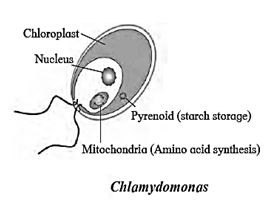
C. Funaria
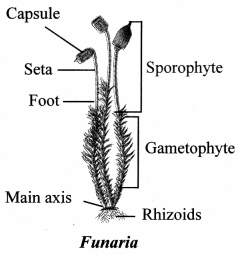
D. Nephrolepis
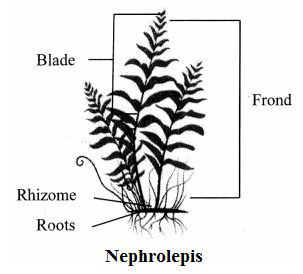
E. Haplontic and haplodiplontic life cycle
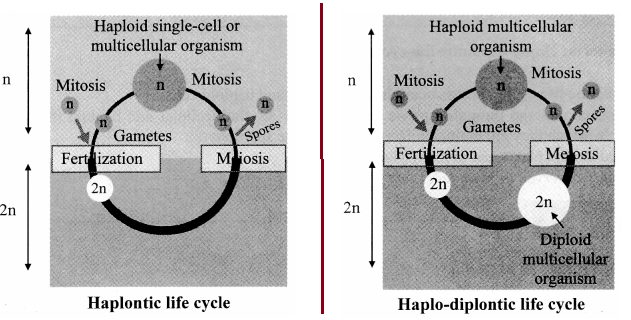
Question 9.
Identify the plant groups on the basis of following features.
- Seed producing plants
- Spore producing plants
- Plant body undifferentiated into Root, Stem and leaves
- Plant need water for fertilization
- First vascular plants
Practical / Project :
1. Study the Nephrolepis plant in detail.
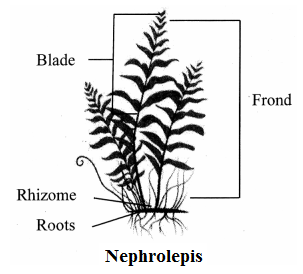
2. Study the coralloid roots, scale leaf and megasporophyll of cycas in detail.
Coralloid roots of Cycas: Scale leaf of Cycas: Megasporophyll of Cycas:
Question 10.
Observe the following diagram. Correct it and write the information in your words.
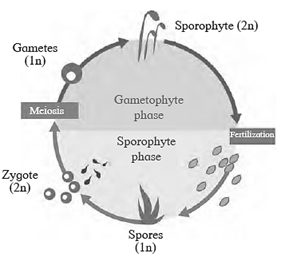
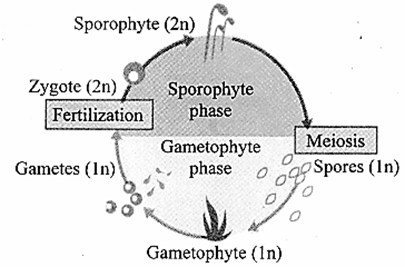
Main Page : – Maharashtra Board Class 11th-Biology – All chapters notes, solutions, videos, test, pdf.
Previous Chapter : Chapter-2-Systematics of Living Organisms – Online Solution
Next Chapter : Chapter-4-Kingdom Animalia – Online Solution
We reply to valid query.